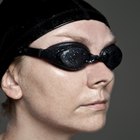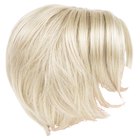
Hoby Finn/Photodisc/Getty Images
Swimming caps are inevitably found in almost every swimmer's swimming equipment bag. Recreational and competitive swimmers will often use swim caps for training and racing. While this simple piece of equipment is not required to swim, it can help you feel more comfortable in the water and also more confident about your swimming.
Materials
With swim caps, you have several options, and it is important to find the one that fits your head comfortably and securely. Swimming caps are available in three main materials: latex, silicon, and lycra. Latex swim caps are typically the least expensive, but they are the most easily broken or torn, and some people may be allergic to the material. Silicon swim caps are quite thicker and sturdier, but they are more expensive. Lycra swim caps are cloth-like and are most appropriate for non lap swimming activities as they are not as secure to your head as the other kinds.
Pool Chemicals
In a study conducted by Marianne Suwalski at the University of Waterloo, results showed the more human hair comes into contact with chlorine, the more damage the hair sustains. There is no swimming cap available that will keep your hair completely dry throughout your swim, but a swimming cap can help limit the amount of water your hair comes into contact with. This will minimize the damaging effects of pool chemicals on your hair.
Hair
Long hair can cause problems for swimmers; it can make it difficult to breath and see in the water when wet hair gets into your face and eyes. Swimming caps solve this problem by holding your hair back and away from your face while swimming. Because of their tightness, latex and silicon swim caps will keep your hair in place best. You may need to periodically adjust your swim cap to ensure your hair is in place and to prevent your cap from pulling your hair.
Drag
Swimmers, especially competitive swimmers, will constantly attempt to become a more efficient athlete, and one way they can do this is by limiting drag on their body. Swim equipment and apparel is engineered to reduce drag on the body. Wearing a proper fitting swim cap can help limit the drag that is caused by your hair.
Goggles
Swimming goggles, which are another key piece of swimming equipment, can work together with your goggles. Your swim cap will protect your hair from being pulled on by your goggle straps while you move through the water. Additionally, the swim cap will help hold your goggle straps in place on your head. Find a cap that fits comfortably and goggles that remain in place while you swim.
Related Articles

How to Tie Your Hair in a Tight Bun for ...

Why Do Swimmers Wear Caps?

How to Wear Swimming Goggles

How to Keep Hair Back When Running

How to Protect Hair from Swimming Pool ...

How to Moisturize Dry Hair Caused by ...

How to Clean a Dirty Epilator

How to Swim With a Hair Weave

Rash Guard for Swimming

How to Moisturize Natural Braids

How to Sleep in Your Wig

How to Keep Your Hat on Your Head ...

Dreadlocks & Outdoor Activities

What Is a Capless Wig?

How to Keep Temporary Dye From Fading

How to Keep Extensions From Falling Out

How to Get Static Out of a Synthetic Wig

How to Remove Human Hair Mats

How to Prevent White Hair From Becoming ...

How to Use Regular Conditioners on ...
References
Writer Bio
Raymond DeWire has worked in the fitness and recreation industry as an aquatic supervisor and swimming coach. He is a former college swimmer and current competitive cyclist. He has a Bachelor's degree in sport and recreation management and a Master's degree in sport management and coaching leadership.
Photo Credits
Hoby Finn/Photodisc/Getty Images